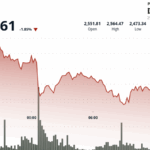
Wall Street Aligns with Bitcoin Surge Alongside Toyotas as Retail Investors Suffer Losses with Their Lamborghinis
What occurs when the retail sector steps back from crypto, while Wall Street shows increasing interest? In light of bitcoin’s recent record high, one might feel optimistic about the industry’s evolution.
This could be true, but we may not be fully there yet. So before we celebrate with flashy rides, it’s crucial to examine the underlying factors.
To start, retail investors seem to have largely ignored this current rally. A quick check of Google Trends for “bitcoin” reveals that the excitement seen during the bull market of 2021 is no longer present. Back then, bitcoin was a hot topic, with many people eagerly exploring altcoins and bombarding social media with emojis of rockets. Fast forward to 2025, and retail participation feels minimal.
There was a temporary spike in retail engagement during the recent U.S. presidential election, highlighted by a brief memecoin craze. However, that enthusiasm quickly faded, with memecoin values plummeting, even as bitcoin soared past $111,000 this week.
“At the start of this cycle, memecoins became a focal point for risk-driven trading, hitting a peak in January,” noted a Toronto-based crypto platform. “Since then, interest has plummeted, reflecting a lukewarm appetite for risk within the crypto space,” they added.
Essentially, the crowd that once shouted “Wen Lambo” has faced losses and isn’t diving back into the market anytime soon.
From Luxurious to Practical
When discussing risk profiles, let’s revisit the automotive analogy.
During the soaring market of 2021, many investors opted for flashy sports cars, ignoring essential safety measures in favor of speed and thrill, blinded by the allure of massive gains.
Now, after facing substantial losses over the years with those impractical vehicles, many traders have switched to more reliable options—think basic and steady sedans that might not be fast but ensure they stay on the road.
This aversion to risk is mirrored in funding rates. According to BTC perpetual rates, which gauge how much traders are willing to pay to maintain their long positions, when bitcoin hit approximately $42,000 in January 2021, the perpetual rate was an eye-watering 185%. Now, near $110,000, that rate sits around 20% on crypto options exchanges, indicating that while there is still some appetite for risk, it’s nowhere near the fervor of 2021.
Nervousness at Record Highs
Another noteworthy aspect is the significant presence of short positions in the market.
Reports indicate that the current bitcoin long/short ratio is the lowest it’s been since the downturn of September 2022. This suggests that many traders are wary of the recent bullish trend and are hedging against further declines in bitcoin.
This positioning was highlighted recently when bitcoin experienced a swift decline from nearly $111,000 to $108,000 in mere minutes before recovering slightly to around $109,000. Such volatility spikes provoke genuine concern.
In this automotive metaphor, investors are still taking their flashy, modified vehicles for joyrides, albeit with practical sedans in tow as a backup plan in case of breakdowns.
Measured Positivity
With current macroeconomic uncertainties, it’s understandable that investors are feeling cautious and risk-averse. However, this mindset could be precisely the formula for a sustainable recovery in the market.
Periods marked by low leverage and restrained risk appetite often precede sustainable price increases in the crypto space.
It appears that bitcoin may be experiencing such a phase, supported by a backdrop of several bullish indicators and narratives.
The reality is that while the retail market’s exuberance has subsided, institutional players are stepping in with their steady, reliable strategies. This might initiate a gradual yet stable ascent, rather than a reckless sprint.


















Post Comment